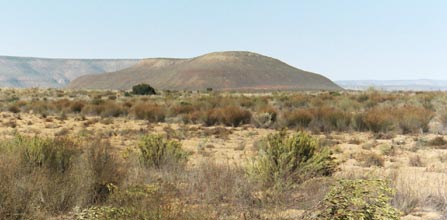A Changing South Africa – Part Four
Air Date: Week of July 16, 2004
Rooibos, or red bush, tea is grown only in the western part of South Africa. The area has a unique climate and ecosystem. Climate scientists are working with farmers in a small town in the region to help them adapt their farming practices to predicted climate change.
Transcript
CURWOOD: It’s Living on Earth. I’m Steve Curwood. It’s daybreak in the far southwestern corner of Africa, a few hours drive north of the Cape of Good Hope. We’re in the wild lands and farming country known as the Succulent Karoo. The broad plateaus look like a desert dotted with shrubs called fynbos, vast and bland except when early spring rains ignite blooms of wildflowers.
Like other parts of South Africa, there are many plants here found nowhere else in the world. Though with its biting winters and scorching summers, the semi-arid Karoo has a radically different climate from much of the rest of the country. Its unique location and size have attracted scientists looking for evidence of the local impact of global climate change.
[TRACTOR ENGINE]
CURWOOD: Farmers here grow grain like oats and barley, and raise sheep. This is also the only place where the famous South African rooibos, or red bush, tea grows. This woody shrub looks much like the many other fynbos bushes, although a closer look reveals shiny dark green leaves shaped much like the herb rosemary.
|
Traditionally, the Khoisan, or Bushmen, brewed a bright reddish-orange tea from the rooibos leaves. Now, thanks to smooth taste of the tea and its reputation as a promoter of health, the cultivation of rooibos is the biggest cash crop for many farmers here, including Koos Koopman.
[TRACTOR STOPS]
KOOPMAN: I grow Rooibus tea. And then I make a little bit of small fruits, a little bit of vegetables in the garden like potatoes, carrots, cabbages, oranges, guavas. I don’t plant vegetables for marketing. I want to do it, but I haven’t got enough money yet to do that.
CURWOOD: Koos Koopman grew up on this land as the son of a colored farm hand. In the days of apartheid, “colored” was a distinct classification different from white or black Africans. Koos’s bronze skin, almond shaped eyes and wiry build suggest he may well have some Khoisan ancestors. He moved away to the city of Cape Town for three decades, but a few years ago after the end of apartheid, he came back to the area. By then he and his brother Barry were in their fifties. They used government assistance to purchase this farm of more than ten square miles from the white farmer who had once employed Koos and his father.
KOOPMAN: I was always thinking of this farm. And so about two years back, I come here one day and he tell me that they got problems. As we sit here in front of the house he ask me, Koos, I want to sell this farm now and I want you to buy this farm.
CURWOOD: So, you’re all in this together, this is a family farm?
|
KOOPMAN: It’s a family farm. Can we go to there? I want to see my pot quickly. I was busy to make some soup for us, for lunchtime.
[FOOTSTEPS]
KOOPMAN (WALKING): You know that’s the way I grow up, with my pots on the outside. We bake our own bread, we make everything for ourselves, you know, we try to purchase as little as possible from the shops. And that’s the only way you can survive on the farm.
[SOUNDS OF BUBBLING SOUP, STIRRING]
CURWOOD: Saving money is especially important when you have a new and high mortgage on your farm. And during the drought of 2003 things were very difficult for Koos -- 40 to 70 percent of his rooibos plantings withered and died. Cultivated rooibos is his biggest source of cash but there was a tiny bright spot: during the drought the wild rooibos plants scattered among the brush on his land seemed to hold their own.
Like every farmer, Koos knows there can be bad years, but he does feel that the seasons are becoming less predictable. I asked him how they are changing.
|
KOOPMAN: Sometimes very hot. Sometimes very cold. I’m not talking about the rain. Cold, and then snow, like a little snow, and it is dry and it burns the plants. And some of the things…when it is wet and the rain fall and it is very cold in the evening, and during the day it gets very hot.
[BLEATING LAMBS AND SHEEP]
CURWOOD: A few kilometers closer to town in Nieuwoudtville, the family of Mariette and Willem van Wyk has been farming for six generations since their ancestors came from the Netherlands.
[TEA BEING POURED]
CURWOOD: Mariette van Wyk pours me a cup of the naturally caffeine-free rooibos tea, and tells me that their operation has also been hit hard by the drought of 2003.
|
VAN WYK: Well, for the past ten years we couldn't complain. And then last year came as a total surprise, being so dry. We had one major rain, but everything failed.
CURWOOD: Usually they harvest 40 tons of rooibos in a year. In 2003, 80 percent of the crop failed. And when it became clear that the magnificent display of spring flowers was also not going to happen, it meant the tourists didn’t come to the bed and breakfast the van Wyks have run for almost two decades.
And with nothing growing for forage they could not afford much in the way of rations for their flock of 2,000 sheep. Parsing out what little grain they did have to the sheep and recently born lambs proved to be a heartbreaker for Mariette.
VAN WYK: When they see the bakkie or the pickup coming they all run to that because they know it's food. In the commotion every mother loses her lamb. Every morning you will find 20, maybe less, hopefully less, sheep or little lambs dead around there … And the first time my husband took me out with him I felt like crawling under the bed when I came back. I just couldn't handle all those little dead bodies lying there.
If we have good rains for the next two years we hope to recover, in about two to three years.
CURWOOD: So let me ask you this: How much does it seem that the weather is outside the normal range of what it seems to have been all the years that your family has been farming here?
VAN WYK: Umm, I am always careful to say this: people are talking a lot about they don't understand the weather any longer. And it's happening later and later that your winter clothes are coming out.
[BUMPING TRUCK]
CURWOOD: On the road along the front of the Suid Bokkeveld Mountains into the town center of Nieuwoudtville, rows of cultivated rooibos look dusty and dry in the heat of what locals say should be a cool early winter day. Signs that this could be more than just the odd dry spell have attracted the interest of scientists at the Climate Systems Analysis Group at the University of Cape Town.
The science involved is complicated, but the general scientific consensus is that the earth is warming because of the widespread burning of coal, oil and gas since the Industrial Revolution, as well as the cutting of vast amounts of forests. The El Niño weather pattern that seems to come more and more often with this warming tends to parch this corner of the planet.
ARCHER: One of the climate change projections is that there will be kind of a longer term drying out, or a reduction, for the broader area. Not just for the Suid Bokkeveld but for interior South Africa.
CURWOOD: Dr. Emma Archer is a geographer with the Climate Systems Analysis Group.
 Dr. Emma Archer (Photo: Steve Curwood)
Dr. Emma Archer (Photo: Steve Curwood)
CURWOOD: Emma Archer is in Nieuwoudtville to get the word out to local farmers that not only should they expect less rain, but they will also get it at different times than they are used to getting it -- and it’s time to start planning how to adapt.
[GENTLE WIND]
CURWOOD: A few years ago a group of rooibos farmers in the Nieuwoudtville area organized themselves into the Heiveld Cooperative, with the help of the Environmental Monitoring Group, an advocacy agency. To boost income, they got their crop certified as organic and developed markets in Europe where the reputed health benefits of rooibos are prized. They are also working on strategies to cope with the effects of long term-drought. Noel Oettle is program manager for the Monitoring Group.
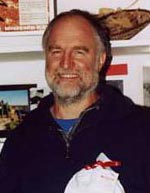 Noel Oettle of the Environmental Monitoring Group (Photo: Eileen Bolinsky)
Noel Oettle of the Environmental Monitoring Group (Photo: Eileen Bolinsky)
CURWOOD: Some growing techniques involve plowing in ways that conserve moisture, and using other plants to block winds that promote drying. And the experience of Koos and other farmers with drought-tolerant wild rooibos is prompting some botanical research as to the feasibility of using the wild tea to help adapt to climate change. Rhoda Louw is a graduate student in botany at the University of Cape Town who is conducting a study with farmers of the Heiveld Cooperative.
LOUW: We’re looking at the sustainable harvesting of Rooibos wild tea….
CURWOOD: …which is relatively slow growing. But Rhoda is looking to see if farmers could gather enough of it to make it economically worthwhile.
LOUW: And we’re looking particularly at the wild rooibos tea because it’s a strong source of income for the people in the Suid Bokkeveld.
CURWOOD: There could be advantages. The cultivated tea that farmers use now can be harvested every year, but it has to be replanted every few years at considerable expense. The wild variety only needs to be carefully harvested by hand where it is found, although it can only be cut every two years.
|
Rhoda and Emma want to take me on a tour of Rhoda’s experimental plots in Koos’s wild rooibos fields. But first, we decide to try a bit of research on our own, from the perspective of a consumer: me.
[TEA POURED, DOG BARKS IN BACKGROUND, TEA POT SET ON TABLE]
LOUW: Would you like some sugar with your tea?
CURWOOD: Oh, no thank you, just a little bit of milk.
[CLINKING]
CURWOOD: If wild rooibos tea is to be successfully marketed, it will need to stand up to the flavor of the popular cultivated rooibos. So Noel, Rhoda and Emma give me a taste test.
CURWOOD: Okay. (SIPS AGAIN) Mmmm, mmmm, this is good (SETS DOWN CUP), this is outstanding.
OETTLE: Steve, you get our "wildman from the North" award (LAUGHTER).
CURWOOD: The cultivated tea is delicious and the wild rooibos tastes great, with a sweet aftertaste like honey.
[KOOPMAN CALLING AND FEEDING SHEEP]
CURWOOD: We’re back on the farm of Koos Koopman to see the wild rooibos tea plants that Rhoda Louw is studying. But before we head for the fields, Koos stops to tend his flock of sheep.
In case of drought, Koos says he’s careful to limit the size of his flock. He wouldn’t want them to overgraze and clean out his wild rooibos. He’d like to sell their meat as organic, but he hasn’t found a market yet. Still, he foregoes hormones and antibiotics in favor of traditional herbs to treat any illnesses in the flock. As we wait to drive to the fields, botanist Rhoda Louw explains how she’ll use the data she’s gathering at the Koopman Farm.
LOUW: We’re trying to marry the scientific knowledge with the indigenous knowledge, which there is a great body of, and try to integrate that. The final product will not be just the thesis, but also a harvesting manual that will come out of the research based on the results.
CURWOOD: What are some of the indicators you are using for your study?
LOUW: One of the research questions is what is the difference between the wild tea and the cultivar. To measure that, we are looking at the life cycles of the two and comparing them over time. Another experiment is we are trying to see which harvest season gives you the greatest re-growth after a year. [CAR DOOR SHUT, DRIVES AWAY]  Rhoda Louw measures a rooibos bush. (Photo: Steve Curwood) Rhoda Louw measures a rooibos bush. (Photo: Steve Curwood)
[KOOS SPEAKING IN AFRIKAANS] LOUW TRANSLATING: This is cultivated tea on both sides. This tea is about six years old. And if you look at this patch over here on my left, you’re going to get more moisture here than down below ARCHER: Koos is saying there is more rainfall here because it’s higher, and you can see that. CURWOOD: But it’s out of the vehicle to see the wild tea, and more than just a short hike. LOUW: I’m going to take you to some of the sites, to some of the samples within the experiment here. [FOOTSTEPS] CURWOOD: Rhoda has about 250 plants in her experiment. The tea bush branches are cut off by hand with a sickle, leaving enough behind so it can keep growing. Farmers already know that the planted or cultivated rooibos might produce for less than a decade. The wild bushes have a longer productive life and can grow to be fifty years old. The wild tea is also more resistant to pests than its cultivated cousin, although the same pests go after both. [MORE FOOTSTEPS THROUGH BRUSH] CURWOOD: Can you move wild rooibos, veld rooibis? Can you move the plant and replant it? KOOPMAN: That is something I experimenting at the moment. I’m busy with it, Rhoda and me, but it don’t work. [FOOTSTEPS] CURWOOD: As we walk through the brush to find the experimental plants, we see one that was harvested the previous year in April, during the drought, and it’s almost dead. Others fared a bit better. And then we come upon a particularly robust rooibos plant, and Rhoda flashes a big smile. LOUW: This is the July, one of the samples harvested in July. CURWOOD: So, this is your more successful one from last year? LOUW: From what I’m seeing, this is the most successful. CURWOOD: What is the traditional time to cut this? KOOPMAN: The traditional time is anytime from February to April. But look at those ones that were cut in January, February and into March. The experiments of that and the growing of that are much slower than the one of July. So, this is something that I’m working on. Maybe. But there’s one thing: you can’t dry the tea in July month because it needs sun and it is our rainy season, July. And we need sun, no rain when we harvest the tea and make the tea. [WIND] LOUW: So the production factors play a role in when tea gets harvested conventionally. But the tea, from what I’m seeing the tea is responding to rain events, not season patterns but rain patterns. [FOOTSTEPS UP AND UNDER] CURWOOD: As we leave the experimental plot, the ironies sink in. Wild tea is more resilient than cultivated tea, but it does its best when it is harvested during the rainy season -- yet traditional methods of curing the tea must be used when there is no chance of rain. Like much good research, this study is raising as many questions as it is answering. For example, what cost-effective techniques could be used to process wild rooibos when it rains? And could timing the harvest according to the rains help the cultivated rooibos, as well? Long established farmers in the region as well as people trying to get started, like Koos, all share the changing climate of this place, and hopefully all can share in the benefits of the adaptation strategies that farmers as well as scientists develop in the coming seasons. [TRUCK DRIVING] CURWOOD: Meanwhile, Koos is working toward a future that he hopes he can pass on to his children. And he’s confident with his experience and faith and the findings of the researchers, he’ll find a way to survive. KOOPMAN: And we pray for the rain. Come and see me in five years time. CURWOOD: What happens if it doesn’t rain? KOOPMAN: Ah, I will never say that it won’t rain. It will rain. God makes summer, winter, spring and everything. You know, that’s one thing that a farmer must have. He must never lose hope. CURWOOD: If there ever was a land of hope, South Africa must be it. More than a decade ago this nation of 40 million people seemed headed for a racial meltdown. But that didn’t happen. And Nelson Mandela, who grew up in the Transkei near the Wild Coast, went from political prisoner to president with remarkably little violence. The nation’s fledgling democracy endures, and now South Africa faces the challenge of reconciling the urgent need of alleviating the poverty that plagues half its population with the critical mission of protecting its fragile ecosystems, from the Karoo to the endangered Pondo trees to the vanishing cheetahs. Democracy came here as all sides strove to forgive and find common ground. Perhaps South Africa can tap that legacy again, this time to find a common goal: to save its ecological riches and enrich all its citizens as it takes its place in the world economy. Links
|

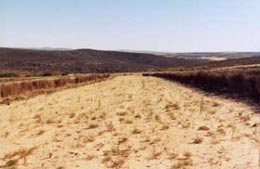 A cultivated rooibos field, after harvest. (Photo: Eileen Bolinsky)
A cultivated rooibos field, after harvest. (Photo: Eileen Bolinsky) 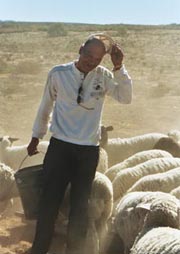 Koos Koopman and his sheep (Photo: Steve Curwood)
Koos Koopman and his sheep (Photo: Steve Curwood) 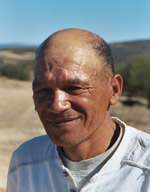 Koos Koopman
Koos Koopman 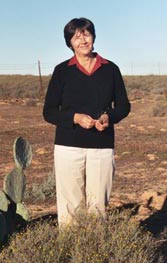 Mariette van Wyk (Photo: Eileen Bolinsky)
Mariette van Wyk (Photo: Eileen Bolinsky) 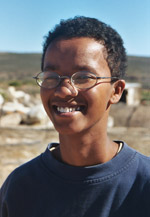 Rhoda Louw (Photo: Steve Curwood)
Rhoda Louw (Photo: Steve Curwood) 